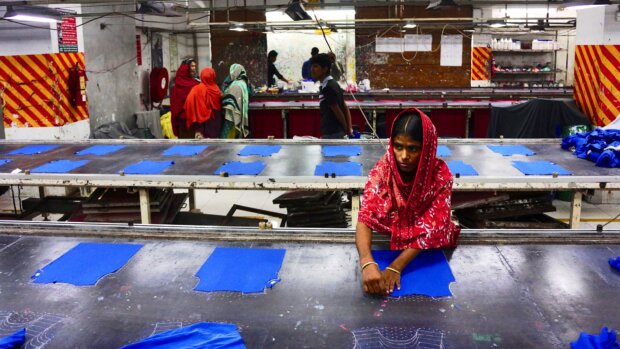- About
- Topics
- Picks
- Audio
- Story
- In-Depth
- Opinion
- News
- Donate
- Signup for our newsletterOur Editors' Best Picks.Send
Read, Debate: Engage.
Textiles. We wear them every day in many different forms. We touch them and even walk on them. Millions of jobs in agriculture, manufacturing, retail and services depend on them through a global supply chain. Yet the way we produce and consume textiles is harming the environment massively and needs to change fundamentally.
Fast fashion and overproduction lead to growing landfills and the squandering of resources and cause damages to the climate through greenhouse gas emissions.
Between 2000 and 2015, the global textile production volume doubled. At the same time, the sector currently accounts for 10 percent of global carbon emissions - equaling the amount that Germany, Russia and Japan emit together. Combined with the high rates of water consumption, it is no surprise that the textile industry is the second largest pollutant globally.
At the C2C Summit Textiles & Supply Chain on 28 January 2021, our Berlin-based NGO had invited speakers from businesses along the global textile supply chain, politicians and representatives from NGOs to discuss how to fundamentally change this industry towards closed resource cycles, true sustainability and social fairness.
There were several issues, on which all panelists agreed. First, we need international legislation focused on a different accounting system that takes the internal carbon pricing and the use of finite resources into consideration. The internalisation of external costs is crucial to enable a circular economy in every sector.
Secondly, we need to invest in textile collection and recycling capacities in order to close the loop and rework used textiles into fibers and subsequently into textiles again. We need those capacities not only for natural fibers like cotton but also for synthetic fibers like nylon. The required technologies already exist, but we need to put them into action and scale them.
Thirdly, commitment by businesses to act more sustainably is imperative for transforming the industry. Companies like the French flooring manufacturer Tarkett with its Desso brand or denim manufacturer Soorty from Pakistan already offer not only products adhering to Cradle to Cradle criteria, but also reorganised their production processes and supply chains to use energy from regenerative resources, establish water stewardship and comply with social standards along their value chain. They did so without legislative endorsement and at the risk of losing money because they are fully aware of the importance of this transformation.
We also need to enhance education and establish networks for small farmers in the Global South, seeing as the textile supply chain starts with them. Initiatives like the RESET program (Regenerate the Environment Society and Economy through Textiles) by the NGO Grameena Vikas Kendram in the Indian region of Andhra Pradesh or the Cotton made in Africa (CmiA) initiative by Aid by Trade Foundation show that small farmers can contribute to a circular economy in the textile sector at the very beginning of the supply chain, while increasing their income and their regions’ biodiversity at the same time.
In addition to the need for truly sustainable production processes, raw materials that are made into textiles must be free of any toxic substances and pollutants. Textiles should not cause any damage to one’s health, neither by being produced nor by being worn. As of today, this is not the case. Cotton textiles are treated with toxic dyes and process chemicals. Synthetic fibers are processed with harmful additives and catalysts.
Altogether, most textiles on the market are not designed for contact with skin. But within a global value chain, the quality of all applied substances is important - whether it is fibers, threads, or dyes. We need textiles designed for skin contact and circulating either in the biological or the technical cycle. This way, we can end the squandering of resources and the emergence of textile landfills. This is especially important in the production countries of the Global South, where the environmental harm caused by today’s production methods have a direct negative social impact.
Cradle to Cradle collections by large brands like C&A, international discount supermarket chains like Lidl or full-service textile providers like Bay City, that produce for their own brands as well as for third parties, show that a circular economy that starts with circular design and healthy materials is already scalable. Commercial success is already linked to sustainable and responsible behavior and will be so even more in the future.
Humanitarian issues, health issues and the climate crisis are “different symptoms of one common crisis. The main problem is that our planet’s boundaries are broken. We need to break the habit of separation, which is an artificial concept, and need to think in systems again”, activist, scholar and author Dr. Vandana Shiva said in her keynote at the Summit. “We need to develop Cradle to Cradle models to maximise production systems that generate biodiversity and reverse climate change,” she concluded. And we could not agree more.
Nora Sophie Griefahn and Tim Janßen are executive directors at Cradle to Cradle (NGO).
Image by Meetin' the world.
